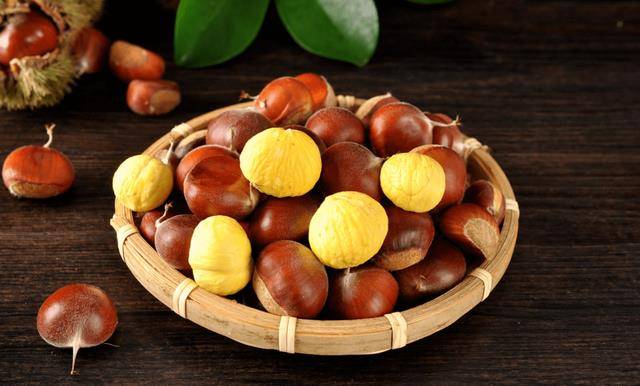Introduction: Chestnuts are an essential food in the autumn and winter seasons. This food has always been reputed as the “king of dried fruits” due to its aromatic fragrance. It is considered a top-grade fruit that is good for stomach and kidney health.
Chestnuts are purplish-brown with a covering of yellow-brown fuzz or are near smooth. The flesh is in a light yellow state and has a delicious sweet taste.
Sweet and soft chestnuts have long been regarded as precious fruits and are considered the best among dried fruits. Although these nuts do not contain as much oil as peanuts, almonds, or walnuts, they have a high starch content.
Nutritional Composition of Chestnuts
Chestnuts are rich in nutrients such as fats, sugars, proteins, minerals, and various vitamins.
Every 100 grams of chestnuts contain 5.6-10.7 grams of protein, 68-70 grams of starch, 2-5.2 grams of fat, and 50-65 grams of carbohydrates.
The vitamin content in raw chestnuts can reach 50-68 milligrams, while in cooked chestnuts, the vitamin content is only 36 milligrams.
Chestnuts also contain potassium, calcium, iron, phosphorus, as well as carotene, B vitamins, and other nutrients.
Benefits of Eating Chestnuts Regularly
Strengthens Bones and Muscles
Chestnuts are rich in phosphorus and calcium, which can help balance the calcium-phosphorus ratio and promote bone development. They can increase bone density and alleviate issues like lower back and knee pain, enhancing bone strength.
Reduces Fatigue
Chestnuts provide energy and nutrients, promoting overall health. They contain abundant B vitamins that help reduce fatigue, enhance mental alertness, and aid in energy recovery.
Boosts Immunity
Chestnuts are rich in nutrients, and consuming them regularly can provide the body with comprehensive nutrition. This helps balance nutrition and strengthens immunity, improving overall health.
Increases Muscle Strength
Eating chestnuts provides rich carbohydrates that supply glycogen to muscles and bones. This enhances muscle strength and endurance by providing energy and essential nutrients.
“Chestnuts” should not be consumed carelessly? Doctors remind: Especially these 6 groups should avoid eating them
Infants under one year old
Although chestnuts contain high-quality proteins that promote bone growth, they also have a high fiber content. For infants under one year old with underdeveloped digestive systems, consuming chestnuts may lead to gastrointestinal issues and digestion problems.
Diabetic Patients
Chestnuts are high in starch and carbohydrates, which can elevate blood sugar levels. Consuming chestnuts excessively can lead to unstable blood sugar levels, making it unfavorable for diabetic individuals.
People with Spleen and Stomach Weakness
While chestnuts are nutritious, they are challenging for the digestive system. Raw chestnuts are hard to digest, while cooked chestnuts may cause bloating. Individuals with weak spleen and stomach functions are advised to avoid consuming chestnuts frequently to prevent worsening digestive issues.
Obese Individuals
Due to the high starch and fat content in chestnuts, obese individuals are not recommended to eat them in large quantities. Overconsumption of chestnuts can lead to excessive calorie intake, contributing to weight gain and worsening obesity-related issues.
During Postpartum Recovery
Although many enjoy eating steamed chestnuts during postpartum recovery for their taste and nutritional benefits, they should be consumed in moderation. The weakened body during postpartum recovery and slow digestive processes can lead to digestive issues and constipation if too many chestnuts are consumed.
Individuals with Constipation
For those who experience constipation, consuming chestnuts regularly is not recommended. Chestnuts can accelerate water loss, exacerbating constipation issues.
Selecting Chestnuts Wisely!
Choosing quality chestnuts involves some tips. For delicious and healthy chestnuts, consider the following:
Pick Chestnuts with More “Fuzz,” Light Color, and Dull Shells
When purchasing chestnuts, opt for those with more fuzz, a lighter color, and dull shells. Such chestnuts are generally tender and tasty. Conversely, chestnuts with less fuzz and a dull appearance indicate they are aged and less flavorful.
Avoid Flat Sides, Look for One Round and One Flat for Sweeter Taste
While selecting chestnuts, pay attention to their shapes. Some are round on one side and flat on the other, while others have two flat sides. It’s recommended to choose chestnuts that are round on one side and flat on the other for a sweeter taste.
Are 10 Chestnuts Equivalent to a Bowl of Rice?
Although chestnuts are nuts, their nutritional composition is similar to starchy foods like potatoes. They have a high starch content, with over 70% carbohydrates, making them comparable to common rice, wheat, and legume foods.
Even fresh chestnuts have a carbohydrate content exceeding 40%, almost double that of sweet potatoes. Rich in plant proteins, carbohydrates, fats, and various minerals, 100 grams of chestnuts contain 436 milligrams of potassium, making them a high-potassium food.
While the saying “10 chestnuts for a bowl of rice” reflects the high carbohydrate and starch content of chestnuts, excessive consumption may lead to digestive issues such as constipation. To enjoy both delicious and healthy chestnuts, it is advisable not to exceed 100 grams daily.


